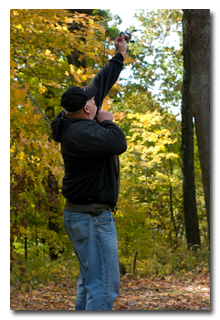
by William Eric McFadden
Pictures
Description
Two members of the Southeast Ohio Radio Adventure Team traveled to Mount Gilead State Park near Mount Gilead, Ohio, for a few hours of play during the first day of the 2012 QRP ARCI Fall QSO Party. Participants were Mike Hansgen, K8RAT, and Eric McFadden, WD8RIF. They were accompanied by Eric's son, Miles, KD8KNC.
 After choosing an unoccupied picnic shelter as the operating location, the trio quickly hung
Eric's 44' doublet and W3EDP wire antennas from well-placed trees.
After choosing an unoccupied picnic shelter as the operating location, the trio quickly hung
Eric's 44' doublet and W3EDP wire antennas from well-placed trees.
The rest of the station consisted of Eric's Elecraft K2 with recently-installed KAT2 internal autotuner, homebrew 4:1 balun; a Whiterook MK-22 Pocket MIni CW Key was used to key the transceiver. Eric's Elecraft KX1 was set up but no QSOs were attemped with this rig.
Only Eric operated, and he used his own callsign. Operations began with the first QSO at 1813 UTC with a 20m QSO with VE7GTU in British Columbia. Only four QSOs were ultimately made, on 20m and 40m. Stations were worked in British Columbia, Ontario, and Florida on 20m and in Alabama on 40m. The last station was worked at 1922 UTC. Few Fall QSO Party stations were heard but many FISTS stations were heard on 40m and many Pennsylvania QSO Party stations were heard on both bands.
One of Eric's primary goals for this outing was to verify the ability of the K2's KAT2 internal autotuner to match his 44' doublet and W3EDP antennas in field conditions. Eric found that the KAT2 easily matched the 44' doublet with 60' of 72Ω twinlead on all bands from 10m and 80m, inclusive. The KAT2 matched the W3EDP on all bands from 10m to 80m, inclusive, but on 40m the KAT2's "ALT" mode was required in order for it to find a nice match; the 17' counterpoise wire was used on all the bands and was deployed on the ground below the main radiator. Both the 44' doublet and the W3EDP antennas were fed through Eric's homebrew 4:1 balun.
Eric also found that the KAT2 could match the W3EDP on 20m and 40m without the 4:1 balun and he used the KAT2's two antenna sockets to perform quick A:B comparisons between the two antennas. On 40m, for the signals listened to, the W3EDP provided significantly stronger reception than the 44' doublet did; this may have been due to the 44' doublet being oriented east-to-west, providing some north-south directivity. On 20m, for the signals listened to, neither antenna appeared to be a stronger performer.
On tear-down, the small-gauge-wire 44' doublet was damaged. Eric plans to rebuild this field-antenna soon with more robust materials.
(return)